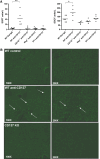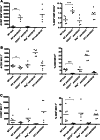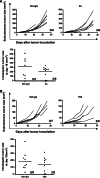Treatment with anti-CD137 mAbs causes intense accumulations of liver T cells without selective antitumor immunotherapeutic effects in this organ
- PMID: 20336294
- PMCID: PMC11030554
- DOI: 10.1007/s00262-010-0846-9
Treatment with anti-CD137 mAbs causes intense accumulations of liver T cells without selective antitumor immunotherapeutic effects in this organ
Abstract
Background/aims: Cancer therapy with agonist anti-CD137 mAbs has been shown to induce immune-mediated tumor rejections in mice, and equivalent agents of this kind are currently being tested in cancer patients. Previous reports indicated that CD137 stimulation induced polyclonal infiltrates of T lymphocytes in the liver. This study characterizes the liver infiltrates and the target dependency of the phenomena and addresses the question of whether tumors nested in the liver are a more favorable target for CD137-based immunotherapy.
Methods: Liver infiltrates were studied with conventional histology and multiple color flow cytometry of total liver leukocytes. CD137(-/-) mice, mice with a single rearrangement of the TCR (OT-1 mice) and Rag(-/-) mice were used to clarify molecular requirements. Mice implanted with MC38 colon carcinomas either subcutaneously or inside the liver were used for comparative studies under treatment with agonist anti-CD137 mAbs.
Results: CD137 treatment caused mononuclear inflammation in the portal spaces of the liver, which gave rise to moderate increases in transaminases without signs of cholestasis. Marked increases in the numbers of CD8+ T cells were observed, including CD8+ T lymphocytes co-expressing CD11c. Infiltrates were absent in CD137(-/-) mice and mitigated in mice harboring a single transgenic TCR on their CD8 T cells. Despite the tumor-independent accumulation of T cells in the liver, immunotherapeutic effects were not more prominent against tumors located in this organ.
Conclusions: Target-dependent effects of CD137 stimulation lead to liver infiltration with T cells, but lymphocyte enrichment in this organ does not privilege this site for immunotherapeutic effects against transplanted tumors.
Figures





Similar articles
-
Abscopal Effects of Radiotherapy Are Enhanced by Combined Immunostimulatory mAbs and Are Dependent on CD8 T Cells and Crosspriming.Cancer Res. 2016 Oct 15;76(20):5994-6005. doi: 10.1158/0008-5472.CAN-16-0549. Epub 2016 Aug 22. Cancer Res. 2016. PMID: 27550452
-
Focusing and sustaining the antitumor CTL effector killer response by agonist anti-CD137 mAb.Proc Natl Acad Sci U S A. 2015 Jun 16;112(24):7551-6. doi: 10.1073/pnas.1506357112. Epub 2015 Jun 1. Proc Natl Acad Sci U S A. 2015. PMID: 26034288 Free PMC article.
-
Combined immunostimulatory monoclonal antibodies extend survival in an aggressive transgenic hepatocellular carcinoma mouse model.Clin Cancer Res. 2013 Nov 15;19(22):6151-62. doi: 10.1158/1078-0432.CCR-13-1189. Epub 2013 Sep 12. Clin Cancer Res. 2013. PMID: 24030703
-
Anti-CD137 antibodies in the treatment of autoimmune disease and cancer.Immunol Res. 2004;29(1-3):197-208. doi: 10.1385/IR:29:1-3:197. Immunol Res. 2004. PMID: 15181282 Review.
-
Boosting Cancer Immunotherapy with Anti-CD137 Antibody Therapy.Clin Cancer Res. 2015 Jul 15;21(14):3113-20. doi: 10.1158/1078-0432.CCR-15-0263. Epub 2015 Apr 23. Clin Cancer Res. 2015. PMID: 25908780 Free PMC article. Review.
Cited by
-
4-1BB Agonists: Multi-Potent Potentiators of Tumor Immunity.Front Oncol. 2015 Jun 8;5:117. doi: 10.3389/fonc.2015.00117. eCollection 2015. Front Oncol. 2015. PMID: 26106583 Free PMC article. Review.
-
Agonist antibodies to TNFR molecules that costimulate T and NK cells.Clin Cancer Res. 2013 Mar 1;19(5):1044-53. doi: 10.1158/1078-0432.CCR-12-2065. Clin Cancer Res. 2013. PMID: 23460535 Free PMC article.
-
Anti-CD137 enhances anti-CD20 therapy of systemic B-cell lymphoma with altered immune homeostasis but negligible toxicity.Oncoimmunology. 2016 Jun 30;5(7):e1192740. doi: 10.1080/2162402X.2016.1192740. eCollection 2016 Jul. Oncoimmunology. 2016. PMID: 27622048 Free PMC article.
-
The promise and challenges of immune agonist antibody development in cancer.Nat Rev Drug Discov. 2018 Jul;17(7):509-527. doi: 10.1038/nrd.2018.75. Epub 2018 Jun 15. Nat Rev Drug Discov. 2018. PMID: 29904196 Review.
-
Antitumor efficacy and reduced toxicity using an anti-CD137 Probody therapeutic.Proc Natl Acad Sci U S A. 2021 Jun 29;118(26):e2025930118. doi: 10.1073/pnas.2025930118. Proc Natl Acad Sci U S A. 2021. PMID: 34172583 Free PMC article.
References
-
- Pollok KE, Kim YJ, Zhou Z, Hurtado J, Kim KK, Pickard RT, Kwon BS. Inducible T cell antigen 4-1BB. Analysis of expression and function. J Immunol. 1993;150:771–781. - PubMed
-
- Kim DH, Chang WS, Lee YS, Lee KA, Kim YK, Kwon BS. Kang CY (2008) 4-1BB engagement costimulates NKT cell activation and exacerbates NKT cell ligand-induced airway hyperresponsiveness and inflammation. J Immunol. 2008;180:2062–2068. - PubMed
Publication types
MeSH terms
Substances
LinkOut - more resources
Full Text Sources
Other Literature Sources
Medical
Research Materials

